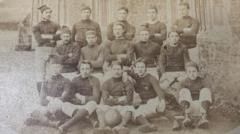Will This Town Finally Get Recognition as the Birthplace of Welsh Rugby After 160 Years?

The Birthplace of Welsh Rugby: A Historical Perspective
In the annals of sports history, few events resonate as profoundly as the birth of a national sport. For Wales, rugby is not just a game; it is a passion that runs deep in the veins of its people. Almost 160 years since two teams contested a rugby match, Lampeter and Llandovery have been officially recognized by the Welsh Rugby Union (WRU) as the co-founders of Welsh rugby. This recognition marks a significant moment in the history of a sport that has united communities and shaped national identity.
The Historical Match: A Look Back at 1866
The historical context surrounding the match played in Caio in 1866 is as intriguing as the sport itself. This landmark game saw Llandovery College face off against Lampeter College on the fields of Glanrannell Farm. The Reverend John Williams, the first warden of Llandovery College, played a pivotal role in introducing rugby to the region after moving from Edinburgh, where he was already acquainted with the game.
As Iestyn Thomas, a former rugby coach at Llandovery College, notes, the introduction of rugby was not merely about the sport itself but also about community engagement. The match coincided with a local spring fair, attracting farm laborers who were drawn to the excitement of the game. Their spontaneous involvement adds a charming anecdote to the historical significance of the event. When spectators jumped onto the field, the referee had to intervene, illustrating how rugby quickly drew the attention of the local populace.
The Growing Legacy of Llandovery College
Following that historic match, Llandovery College continued to flourish in the world of rugby. The college became instrumental in producing stellar players who would go on to represent Wales on the international stage. In fact, two players from Llandovery participated in the first-ever international rugby fixture for Wales, showcasing the college's early commitment to the sport.
By 1881, Llandovery College was present during the formation of the WRU, solidifying its place in rugby history. The legacy of the college has continued to thrive, with notable alumni such as Alun Wyn Jones and George North, who have left indelible marks on Welsh rugby. Today, the college’s connections to professional teams, like the Scarlets, signal a bright future for aspiring players.
The Role of Lampeter University
While Llandovery has made significant contributions to rugby, Lampeter University has also played a critical role in the sport's development. Recognizing both locations as co-founders of Welsh rugby acknowledges the collaborative spirit that has characterized the sport from its inception. The entrance signs marking this historical link serve as reminders of the rich heritage shared by these two towns.
Impact on Local Communities
The recognition of Lampeter and Llandovery as co-founders of Welsh rugby has brought renewed attention to the towns and their storied past. Councillor Handel Davies expressed that the acknowledgment took many residents by surprise, with many unaware of the historical significance of their towns in the rugby landscape. Such realizations foster community pride and encourage local engagement in promoting rugby as an essential part of their identity.
The Call for Recognition of Caio
Despite the focus on Lampeter and Llandovery, there’s a growing sentiment in Caio that the village deserves recognition for its role in hosting the first-ever competitive rugby match in Wales. One villager suggested the installation of a plaque on Glanrannell field to commemorate the historical event. This call for recognition highlights the interconnectedness of these communities and their shared history.
The Evolution of Rugby in Wales
Rugby has evolved significantly since that first match in 1866. From the early days of informal games played in fields to the modern professional sport we see today, the journey of rugby in Wales is fascinating. The WRU has played a crucial role in this evolution, managing the sport at all levels and ensuring that it remains accessible to everyone, from schoolchildren to international stars.
Wales has produced some of the world’s most renowned rugby players, and the sport has become a source of national pride. Major tournaments, such as the Six Nations Championship and the Rugby World Cup, showcase the talent and dedication of Welsh players, further solidifying rugby's status as Wales' national sport.
Rugby as a Unifying Force
Beyond its physical demands, rugby has proven to be a unifying force for communities across Wales. Matches often draw large crowds, creating a sense of camaraderie among fans. Local clubs foster connections between families and friends, creating lifelong bonds through shared experiences on and off the field. The sport has also become a platform for social change, promoting values such as teamwork, respect, and resilience.
The Future of Welsh Rugby
As the story of rugby in Wales continues to unfold, the future looks promising. With institutions like Llandovery College nurturing young talent, and a firm commitment from the WRU to promote the sport at grassroots levels, the foundation is set for another century of rugby excellence. The involvement of current players and coaches, such as Nathan Thomas, serves to inspire the next generation of athletes.
With a growing emphasis on youth development, the pathway to professional rugby has become more accessible. Initiatives aimed at encouraging participation in schools and communities are crucial in ensuring that rugby remains a vibrant part of Welsh culture. The recent achievements of Llandovery College, including the introduction of young players into the professional game, signify a bright future for Welsh rugby.
Conclusion: A Legacy Worth Celebrating
The recognition of Lampeter and Llandovery as co-founders of Welsh rugby is a testament to the enduring legacy of the sport in Wales. This acknowledgment not only honors the past but also inspires future generations to embrace rugby as a vital part of their identity. With the rich history of rugby in these towns and the exciting prospects ahead, it’s clear that the spirit of the game will continue to thrive.
FAQs about the Birthplace of Welsh Rugby
What year was the first rugby match played between Llandovery College and Lampeter College?
The first rugby match between Llandovery College and Lampeter College was played in 1866 at Glanrannell Farm in Caio.
Who is credited with bringing rugby to Llandovery?
The Reverend John Williams, the first warden of Llandovery College, is credited with introducing rugby to the town after moving from Edinburgh.
What is the significance of the entrance signs in Lampeter and Llandovery?
The entrance signs mark the historical link between the two towns and their significant roles in the development of Welsh rugby.
Why is Caio significant in Welsh rugby history?
Caio is significant as it hosted the first-ever competitive rugby match between two Welsh clubs or institutions, making it a vital part of rugby history.
How has rugby evolved in Wales since the first match?
Rugby in Wales has evolved from informal matches to a professional sport, with the establishment of the WRU and significant contributions from various clubs and institutions.
As we celebrate the past, present, and future of Welsh rugby, how do you see the sport evolving in the next decade? #WelshRugby #SportsHistory #CommunityPride
Published: 2025-08-01 21:55:12 | Category: wales



